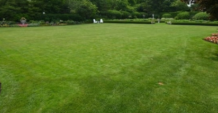November is the time to give cool-season lawns the last nitrogen application of the season. Why November? Because while top growth slows in response to cool temperatures, grass plants are still making food (carbohydrates) by photosynthesis. A November nitrogen application helps boost the photosynthesis rate. Carbohydrates that are not used in growth are stored in the crown and other storage tissues in the plant. These carbohydrate reserves help the turfgrass green up earlier in the spring and sustain growth into May without the need for early-spring (March or April) nitrogen. Those early-spring nitrogen applications are less desirable because they can lead to excessive shoot growth and reduced root growth. Other benefits of November-applied nitrogen for cool-season grasses include improved winter hardiness, root growth and shoot density.
How much should you apply? One to 1 to 1 ½ pounds actual nitrogen per 1,000 sq. ft. of lawn area is sufficient. Following the recommended spreader setting on the fertilizer bag should apply the correct amount of fertilizer. In order for this application to be effective, the nitrogen must be readily available to the plant, because the growing season is nearly over. Therefore, for a November application, use a soluble (quickly-available) nitrogen carrier such as urea or ammonium sulfate.
Many turfgrass fertilizers sold in garden centers and other retail outlets also contain soluble nitrogen. Avoid products that contain water-insoluble nitrogen (slow-release) for this application. As always, sweep up any fertilizer that gets on driveways, sidewalks, or streets and reapply it to the lawn.
Credit KSU – Ward Upham
Photo credit: Perfect Grass




